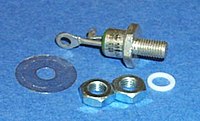
Photo from wikipedia
This manuscript details the construction and demonstration of the first known microwave three-wave mixing (M3WM) experiment utilizing multiple arbitrary waveform generators (AWGs) completely operable in the 6–18 GHz frequency range… Click to show full abstract
This manuscript details the construction and demonstration of the first known microwave three-wave mixing (M3WM) experiment utilizing multiple arbitrary waveform generators (AWGs) completely operable in the 6–18 GHz frequency range for use in chirality determination and quantification. Many M3WM techniques, which involve two orthogonal, subsequent Rabi π/2 and π microwave pulses, suffer from flexibility in pulse types and timings as well as frequency due to most instruments only using one, one-channel AWG and the M3WM probability decreasing with an increasing quantum number, J. In this work, we presented an M3WM instrument that allows that flexibility by introducing multiple, synchronized AWGs and adheres to the high probability transition loop pathways in carvone. The functionality and reliability of the instrument were demonstrated using a series of experiments and mixtures of the R and S enantiomers and determined to be of similar accuracy to other reported M3WM setups with the additional benefit of flexibility in pulsing schemes.
Journal Title: Symmetry
Year Published: 2022
Link to full text (if available)
Share on Social Media: Sign Up to like & get
recommendations!